Experience Tumblr Like Never Before
Space Pictures - Blog Posts
Roman’s Family Portrait of Millions of Galaxies
About 15 years ago, our Hubble Space Telescope captured this ultra-deep field image of space, revealing thousands of galaxies tucked away in a seemingly empty spot in the sky.

Now, imagine this view of the cosmos – and all the mysteries in it – at a scale 300 times larger than Hubble's.
Our upcoming Nancy Grace Roman Telescope could capture just that.

Roman recently released this gorgeous simulated image that gives us a preview of what the telescope could see. Each tiny speck represents a galaxy filled with billions of stars. And it’s more than just a pretty picture – scientists could learn a lot from an observation like this!

Since Roman can see much more of the sky at a time, it could create an ultra-deep field image that’s far larger than Hubble’s. So instead of revealing thousands of galaxies, Roman would see millions!

Roman’s ability to look far out into space with such an expansive view would help us better understand what the universe was like when it was young. For example, scientists could study a lot of cosmic transitions, like how galaxies switch from star-making factories to a quieter stage when star formation is complete and how the universe went from being mainly opaque to the brilliant starscape we see today.

And these are just a few of the mysteries Roman could help us solve!
Set to launch in the mid-2020s, our Nancy Grace Roman Space Telescope, is designed to unravel the secrets of dark energy and dark matter, search for and image exoplanets, and explore many topics in infrared astrophysics. You can learn about some of the other science Roman will do here.
Make sure to follow us on Tumblr for your regular dose of space!
Stars, Sea, and Smoke from the ISS: Tournament Earth 2021
We started Tournament Earth with 32 photos taken by astronauts from the Interantional Space Station and now we are down to 8. All of the #1 seeds are gone. Two #8 seeds are dominating their groups. Who will win? Let's take a closer look at the competitors still in the game. Then remember to vote for your favorites. The champion will be announced on April 13, 2021.
Stars in Motion vs. Cleveland Volcano
This matchup pits smoke against stars, but both have interesting stories.

The International Space Station (ISS) is constantly in motion. For astronaut photographers on board, that motion has consequences. For one, it makes it challenging to take photos. The same motion makes it possible to shoot spectacular photos like the one above. The image is compiled from a series of photographs taken by astronaut Don Pettit while he was onboard the ISS in April 2012. This composite was made from more than 72 individual long-exposure photographs taken over several minutes as the ISS traveled over the Caribbean Sea, across South America, and over the South Atlantic Ocean.

Astronaut Jeff Williams was the first to witness activity at the Cleveland Volcano on May 3, 2006. The Cleveland Volcano is one of the most active in the Aleutian Islands, which extend west-southwest from the Alaska mainland. It is a stratovolcano composed of alternating layers of hardened lava, compacted volcanic ash, and volcanic rocks. The event proved to be short-lived; two hours later, the plume had completely detached from the volcano. The ash cloud height could have been as high as 6,000 meters (20,000 feet) above sea level.
Stargazing from the ISS vs. Cruising Past the Aurora Borealis
This is the most stellar matchup of the tournament, literally. Two beloved star pictures face off in what will be one of the most difficult choices of the tournament.

An astronaut took this broad, short-lens photograph of Earth’s night lights while looking out over the remote reaches of the central equatorial Pacific Ocean. The ISS was passing over the island nation of Kiribati at the time, about 2600 kilometers (1,600 miles) south of Hawaii. Scientists identified the pattern of stars in the photo as our Milky Way galaxy (looking toward its center). The dark patches are dense dust clouds in an inner spiral arm of our galaxy; such clouds can block our view of stars toward the center. The curvature of the Earth crosses the center of the image and is illuminated by a variety of airglow layers in orange, green, and red.

Commonly known as the northern lights, these colorful ribbons of light appear to dance in the sky over the planet’s high latitudes, attracting sky chasers and photographers. Astronaut Randy “Komrade” Bresnik shot this photograph on September 15, 2017, as the space station passed over Ontario, Canada. Curtains of green—the most familiar color of auroras—dominate the light show, with hints of purple and red.
Rolling Through the Appalachians vs. Castellanus Cloud Tower

The Susquehanna River cuts through the folds of the Valley-and-Ridge province of the Appalachian Mountains in this photograph taken from the International Space Station by astronaut Christina Koch. The Valley-and-Ridge province is a section of the larger Appalachian Mountain Belt between the Appalachian Plateau and the Blue Ridge physiographic provinces. The northeast-southwest trending ridges are composed of Early Paleozoic sedimentary rocks. The valleys between them were made of softer rocks (limestone and shales) that were more susceptible to erosion; they are now occupied by farms.

An astronaut aboard the International Space Station took this photograph of a massive vertical cloud formation—known to meteorologists as cumulus castellanus—above Andros Island. The cloud name castellanus comes from the similarity to the crenellated towers or turrets of medieval castles. These clouds develop due to strong vertical air movement typically associated with thunderstorms.
Lake Van, Turkey vs. Typhoon Maysak from the Space Station

While orbiting on the International Space Station, astronaut Kate Rubins shot this photograph of part of Lake Van in Turkey, the largest soda or alkaline lake on Earth. Generally, soda lakes are distinguished by high concentrations of carbonate species. Lake Van is an endorheic lake—it has no outlet, so its water disappears by evaporation—with a pH of 10 and high salinity levels.

This photograph of super typhoon Maysak was taken by European Space Agency astronaut Samantha Cristoforetti as the International Space Station passed near the storm on March 31, 2015. The category 4 typhoon was headed for a possible landfall in the Philippines by the end of the week. It was unusual for the western Pacific to see such a strong storm so early in the year.
See all of the images and vote HERE. Follow @NASAEarth on social media for updates.
Make sure to follow us on Tumblr for your regular dose of space: http://nasa.tumblr.com
New Rose-Colored Glasses for the Roman Space Telescope
Big news for our Nancy Grace Roman Space Telescope! Thanks to some new “shades” – an infrared filter that will help us see longer wavelengths of light – the mission will be able to spot water ice on objects in the outer solar system, see deeper into clouds of gas and dust, and peer farther across space. We’re gearing up for some super exciting discoveries!
Rocks on the rocks
You probably know that our solar system includes planets, the Sun, and the asteroid belt in between Mars and Jupiter – but did you know there’s another ‘belt’ of small objects out past Neptune? It’s called the Kuiper belt, and it’s home to icy bodies that were left over from when our solar system formed.

A lot of the objects there are like cosmic fossils – they haven’t changed much since they formed billions of years ago. Using its new filter, Roman will be able to see how much water ice they have because the ice absorbs specific wavelengths of infrared light, providing a “fingerprint” of its presence. This will give us a window into the solar system’s early days.
Upgraded heat vision
Clouds of dust and gas drift throughout our galaxy, sometimes blocking our view of the stars behind them. It’s hard for visible light to penetrate this dusty haze because the particles are the same size or even larger than the light’s wavelength. Since infrared light travels in longer waves, it hardly notices the tiny particles and can pass more easily through dusty regions.

With Roman’s new filter, we’ll be able to see through much thicker dust clouds than we could have without the upgrade. It’ll be much easier to study the structure of our home galaxy, the Milky Way.

Roman’s expanded view will also help us learn more about brown dwarfs – objects that are more massive than planets, but not massive enough to light up like stars. The mission will find them near the heart of the galaxy, where stars explode more often.
These star explosions, called supernovae, are so extreme that they create and disperse new elements. So near the center of the galaxy, there should be higher amounts of elements that aren’t as common farther away, where supernovae don’t happen as often.
Astronomers think that may affect how stars and planets form. Using the new filter, Roman will probe the composition of brown dwarfs to help us understand more.
Baby galaxies
Roman’s upgraded filter will also help us see farther across space. As light travels through our expanding universe, its wavelength becomes stretched. The longer it travels before reaching us, the longer its wavelength becomes. Roman will be able to see so far back that we could glimpse some of the first stars and galaxies that ever formed. Their light will be so stretched that it will mostly arrive as infrared instead of visible light.

We’re still not sure how the very first galaxies formed because we’ve found so few of these super rare and faint beasts. But Roman will have such a big view of the universe and sharp enough vision that it could help us find a lot more of them. Then astronomers can zoom in on them with missions like our James Webb Space Telescope for a closer look.
Roman will help us explore these cosmic questions and many more! Learn more about the mission here: https://roman.gsfc.nasa.gov/
Make sure to follow us on Tumblr for your regular dose of space: http://nasa.tumblr.com
Galaxies: Cities of Stars
Galaxies are like cities made of oodles of stars, gas, and dust bound together by gravity. These beautiful cosmic structures come in many shapes and sizes. Though there are a slew of galaxies in the universe, there are only a few we can see with the unaided eye or backyard telescope.
How many types are out there, how’d so many of them wind up with weird names, and how many stars live inside them? Hold tight while we explore these cosmic metropolises.

Galaxies come in lots of different shapes, sizes, and colors. But astronomers have noticed that there are mainly three types: spiral, elliptical, and irregular.
Spiral galaxies, like our very own Milky Way, look similar to pinwheels! These galaxies tend to have a bulging center heavily populated by stars, with elongated, sparser arms of dust and stars that wrap around it. Usually, there’s a huge black hole hiding at the center, like the Milky Way’s Sagittarius A* (pronounced A-star). Our galactic neighbor, Andromeda (also known as Messier 31 or M31), is also a spiral galaxy!

Elliptical galaxies tend to be smooth spheres of gas, dust, and stars. Like spiral galaxies, their centers are typically bulges surrounded by a halo of stars (but minus the epic spiral arms). The stars in these galaxies tend to be spread out neatly throughout the galaxies and are some of the oldest stars in the universe! Messier 87 (M87) is one example of an elliptical galaxy. The supermassive black hole at its center was recently imaged by the Event Horizon Telescope.

Irregular galaxies are, well … a bit strange. They have one-of-a-kind shapes, and many just look like messy blobs. Astronomers think that irregular galaxies' uniqueness is a result of interactions with other galaxies, like collisions! Galaxies are so big, with so much distance between their stars, that even when they collide, their stars usually do not. Galaxy collisions have been important to the formation of our Milky Way and others. When two galaxies collide, clouds of gas, dust, and stars are violently thrown around, forming an entirely new, larger one! This could be the cause of some irregular galaxies seen today.

Now that we know the different types of galaxies, what about how many stars they contain? Galaxies can come in lots of different sizes, even among each type. Dwarf galaxies, the smallest version of spiral, elliptical, and irregular galaxies, are usually made up of 1,000 to billions of stars. Compared to our Milky Way’s 200 to 400 billion stars, the dwarf galaxy known as the Small Magellanic Cloud is tiny, with just a few hundred million stars! IC 1101, on the other hand, is one of the largest elliptical galaxies found so far, containing almost 100 trillion stars.

Ever wondered how galaxies get their names? Astronomers have a number of ways to name galaxies, like the constellations we see them in or what we think they resemble. Some even have multiple names!
A more formal way astronomers name galaxies is with two-part designations based on astronomical catalogs, published collections of astronomical objects observed by specific astronomers, observatories, or spacecraft. These give us cryptic names like M51 or Swift J0241.3-0816. Catalog names usually have two parts:
A letter, word, or short acronym that identifies a specific astronomical catalog.
A sequence of numbers and/or letters that uniquely identify the galaxy within that catalog.
For M51, the “M” comes from the Messier catalog, which Charles Messier started compiling in 1771, and the "51" is because it’s the 51st entry in that catalog. Swift J0241.3-0816 is a galaxy observed by the Swift satellite, and the numbers refer to its location in the sky, similar to latitude and longitude on Earth.

There’s your quick intro to galaxies, but there’s much more to learn about them. Keep up with NASA Universe on Facebook and Twitter where we post regularly about galaxies.
Make sure to follow us on Tumblr for your regular dose of space: http://nasa.tumblr.com.
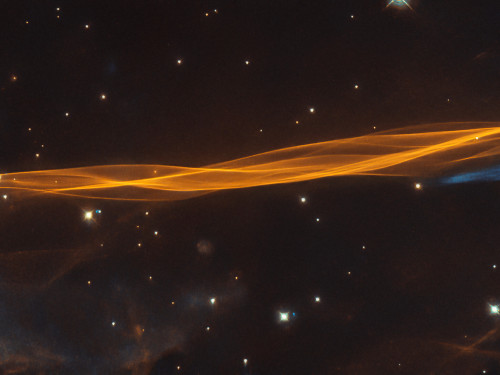
Do you believe in magic? ✨ While appearing as a delicate and light veil draped across the sky, this @NASAHubble image reminds us of the power of imagination. What does this look like to you? In reality, it's a small section of a Cygnus supernova blast wave, located around 2,400 light-years away. The original supernova explosion blasted apart a dying star about 20 times more massive than our Sun between 10,000 and 20,000 years ago. Since then, the remnant has expanded 60 light-years from its center. Credit: @ESA/Hubble & NASA, W. Blair; acknowledgment: Leo Shatz
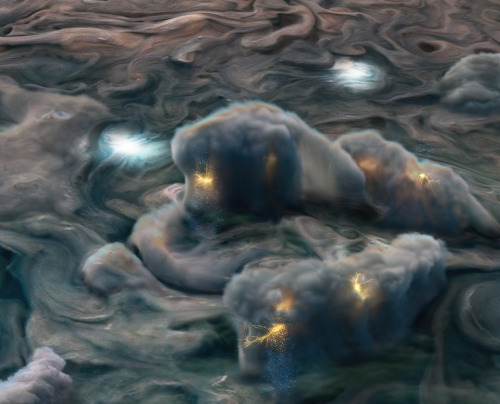
New results from our Juno mission suggest the planet is home to “shallow lightning.” An unexpected form of electrical discharge, shallow lightning comes from a unique ammonia-water solution.
It was previously thought that lightning on Jupiter was similar to Earth, forming only in thunderstorms where water exists in all its phases – ice, liquid, and gas. But flashes observed at altitudes too cold for pure liquid water to exist told a different story. This illustration uses data obtained by the mission to show what these high-altitude electrical storms look like.
Understanding the inner workings of Jupiter allows us to develop theories about atmospheres on other planets and exoplanets!
Illustration Credit: NASA/JPL-Caltech/SwRI/MSSS/Gerald Eichstädt/Heidi N. Becker/Koji Kuramura
Make sure to follow us on Tumblr for your regular dose of space: http://nasa.tumblr.com

Clouds swirling in the coffee colored atmosphere of Jupiter, looks more like a familiar morning beverage of champions.
This image from our Juno spacecraft was captured in North North Temperate Belt. Image Credit: Enhanced Image by Gerald Eichstädt and Sean Doran (CC BY-NC-SA)/NASA/JPL-Caltech/SwRI/MSSS
Make sure to follow us on Tumblr for your regular dose of space: http://nasa.tumblr.com
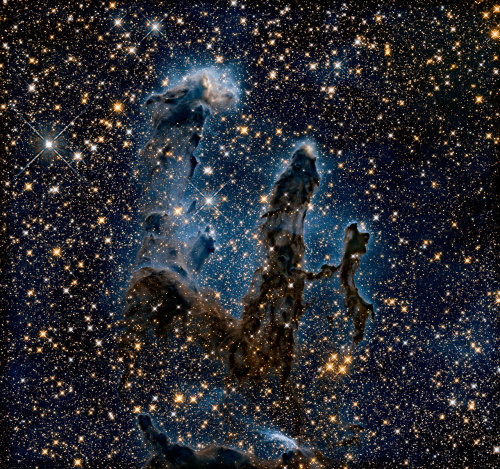
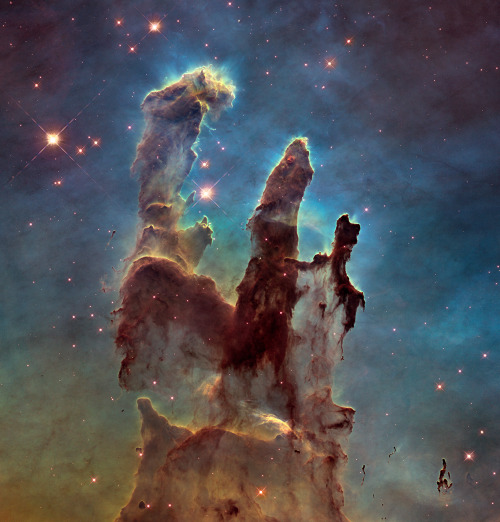
Sometimes... there’s more than meets the eye. 👀 You’re looking at two very different takes on an iconic image.
Human eyes can see only a small portion of the range of radiation given off by the objects around us. We call this wide array of radiation the electromagnetic spectrum, and the part we can see visible light.
In the first image, researchers revisited one of Hubble Space Telescope’s most popular sights: the Eagle Nebula’s Pillars of Creation. Here, the pillars are seen in infrared light, which pierces through obscuring dust and gas and unveil a more unfamiliar — but just as amazing — view of the pillars. The entire frame is peppered with bright stars and baby stars are revealed being formed within the pillars themselves. The image on the bottom is the pillars in visible light.
Image Credit: NASA, ESA/Hubble and the Hubble Heritage Team
Make sure to follow us on Tumblr for your regular dose of space: http://nasa.tumblr.com.

If we could squeeze a galaxy, it would be this fluffy-looking one.
Spiral galaxies like this, located 60 million light-years away, have supermassive black holes at their bright centers. Astronomers are trying to understand this cozy relationship.
Make sure to follow us on Tumblr for your regular dose of space: http://nasa.tumblr.com.

“Only in the darkness can you see the stars.” —Martin Luther King, Jr. Pause for a moment and take in the vastness and beauty of our home planet captured from the vantage point of space. On this spaceship we call Earth, we are all in this together. 💙
Make sure to follow us on Tumblr for your regular dose of space: http://nasa.tumblr.com.
On Top of The World – Literally
What’s one perk about applying to #BeAnAstronaut? You’re one step closer to being on top of the world.

Part of the job of a NASA astronaut is a task called spacewalking. Spacewalking refers to any time an astronaut gets out of a vehicle while in space; it is performed for many reasons such as completing repairs outside the International Space Station, conducting science experiments and testing new equipment.

Spacewalking can last anywhere from five to eight hours, and for that reason, astronauts’ spacesuits are more like mini-spacecraft than uniforms! Inside spacesuits, astronauts have the oxygen they need to breathe, water to drink and a bathroom!

Spacesuits also protect astronauts from the extreme environment of space. In Earth orbit, conditions can be as cold as minus 250 degrees Fahrenheit. In the sunlight, they can be as hot as 250 degrees. A spacesuit protects astronauts from those extreme temperatures.

To stay safe during spacewalks, astronauts are tethered to the International Space Station. The tethers, like ropes, are hooked to the astronaut and the space station – ensuring the astronaut does not float away into space.

Spacewalking can be a demanding task. Astronauts can burn anywhere from ~1500-2500 calories during one full assignment. That’s about equal to running 2/3 of a marathon.

Does spacewalking sound like something you’d be interested in? If so, you might want to APPLY to #BeAnAstronaut! Applications are open until March 31. Don’t miss your chance to!

Want to learn more about what it takes to be an astronaut? Or, maybe you just want more epic images. Either way, check out nasa.gov/astronauts for all your NASA astronaut needs!
Make sure to follow us on Tumblr for your regular dose of space: http://nasa.tumblr.com
Cosmic Piece of Pi!
Did you know that pi is involved nearly anywhere you look? We’re not talking about your favorite pastry! Pi (also written as the Greek letter 𝞹, or the number 3.14159...) is an irrational number, which means it can’t be written as a simple fraction like ½. It is the ratio of a circle’s circumference (the distance around its edge) to its diameter (the distance across it) and will always be the same number, regardless of the circle’s size. Here are some places you can find pi in the universe around us!

Our Transiting Exoplanet Survey Satellite, TESS, watches slices of the sky in its hunt for worlds outside our solar system — how many exoplanets are in its night-sky pie? Last July, TESS scientists created a mosaic of 208 images of the southern sky. At that time, it contained 29 confirmed and 1,000 possible exoplanets, and we’re still studying the data to find more. Since this awe-inspiring image is of the southern hemisphere (or half of a 3D circle), there will always be pi! Every slice contains something delicious for scientists to study.

Pi recently played a crucial role in new discoveries about Alpha Draconis, a well-studied pair of stars. After discovering these stars regularly eclipse each other, pi helped scientists learn more about them. Scientists detected the eclipses while monitoring the brightness of Alpha Draconis for periodic dips that could’ve been caused by planets passing between the star and us. Instead of a planet, though, researchers found that its smaller partner in crime was passing in between us and the larger star for about six hours at a time! 💫

Pi comes in handy as we learn more about these two stars. Knowing the percentage of the decrease in Alpha Draconis’ light and the formula for the area of a circle (A=𝞹r2 — or area equals pi times the square of the circle's radius), scientists can predict the sizes of both stars. Because stars typically orbit in an elliptical (or oval) shape, pi also helps scientists use the detection of these eclipses to figure out the orbits of the two stars!
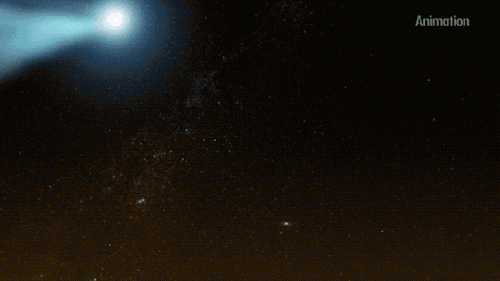
So far we’ve seen pi in many places! But it's also interesting to look at where pi can't be found! We mentioned earlier that many orbit calculations involve pi … but not every one does! Pi does not factor into calculations of hyperbolic orbits — orbits that aren't complete, or don't return to where they started — the same way that it does with elliptical orbits! This is most commonly seen with comets. While many comets orbit normally in our solar system, some oddballs just pass through, like the interstellar ‘Oumuamua that zipped passed us in 2017. ☄️

Perhaps the most popular place you may find pi is in the shape of a typical pie! While NASA’s Fermi Gamma-ray Space Telescope studies gamma-rays, and not blueberries, we think this cool Fermi pie is worth sharing for Pi Day!
Find more ways scientists look up at the night sky and use pi here. And now, don’t be irrational, and go have some pi(e)! 🥧
Make sure to follow us on Tumblr for your regular dose of space: http://nasa.tumblr.com

The trickster “Blinking Planetary”
Planetary nebula NGC 6826 is located about 4,200 light years from Earth in Cygnus. When observers look directly at it through a small telescope, they typically see only the nebula’s sparkling-white central star. However, by averting one’s gaze, glancing away from the central star, the nebula’s bulbous dust clouds come into view. This optical trickery earned this planetary nebula the name the "Blinking Planetary.”
Over the next several thousand years, the nebula will gradually disperse into space, and then the central star will slowly cool as it radiates its energy for billions of years as a white dwarf.
Make sure to follow us on Tumblr for your regular dose of space: http://nasa.tumblr.com
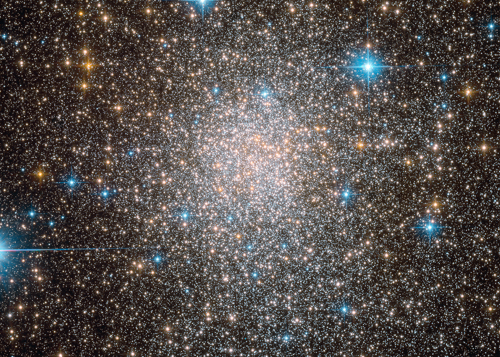
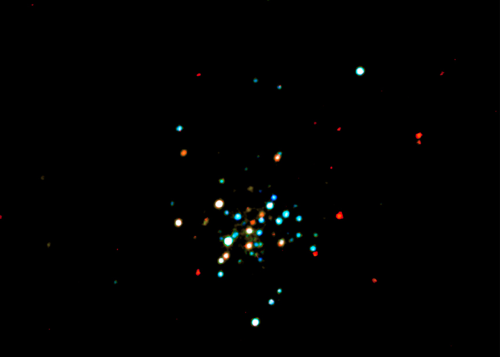
Even star systems have identity crises. 🤷 According to data from observatories like our @nasachandraxray, a double star system has been rapidly flipping between two alter egos: a low-mass X-ray binary and a millisecond pulsar. Astronomers found this volatile double system in a dense collection of stars known as Terzan 5. The first image from @NASAHubble shows Terzan 5 in optical light. Swipe to see the new image where low, medium and high-energy X-rays detected by Chandra are colored red, green and blue respectively. Click the link in bio for more.
Make sure to follow us on Tumblr for your regular dose of space: http://nasa.tumblr.com

#TBT to 1989 when Voyager 2 spotted Uranus looking like a seemingly perfect robin’s egg. 💙 When our Voyager 2 spacecraft flew by it in this image, one pole was pointing directly at the Sun. This means that no matter how much it spins, one half is completely in the sun at all times, and the other half is in total darkness.. Far-flung, Uranus – an ice giant of our solar system – is as mysterious as it is distant. Soon after its launch in 2021, our James Webb Space Telescope will change that by unlocking secrets of its atmosphere. Image Credit: NASA/JPL-Caltech
Make sure to follow us on Tumblr for your regular dose of space: http://nasa.tumblr.com
When Dwarfs Meet Giants, and Other True Cosmic Fairy Tales
It’s easy to get lost in fantasy worlds through science-fiction movies and novels, but did you know that some of your favorite fairy tale characters actually exist in cosmic form? From dwarfs and giants to shape-shifters and buried treasure, the universe is home to a multitude of mystical objects.
White Dwarf Stars

You’ve probably heard of dwarfs like Happy and Sneezy (or Gimli and Thorin), but it’s unlikely you’re familiar with the space-dwelling dwarfs with names like Sirius B and ASASSN-16oh. White dwarf stars like these are typically about the size of Earth, which is pretty small as far as stars go. They represent one of three final stages of stellar evolution, along with neutron stars and black holes. Each star’s mass determines which one it will ultimately become. Stars much more massive than the Sun typically become neutron stars or black holes, and lower-mass stars end up as white dwarfs.

Our Sun will eventually become a white dwarf after it exhausts its fuel, but don’t worry — we’ve got several billion years to go! Before it is reduced to a white dwarf it will actually expand into a red giant, swelling out to encompass Earth’s orbit. But we don’t have to wait billions of years to see stellar giants … some already peek out at us from the cosmic deep.
Giants and Supergiants

The red giant star Aldebaran, located about 65 light-years away, is about 5,000 times bigger than Earth. Our Cassini spacecraft imaged Aldebaran through Saturn’s rings in 2006, but you can see it for yourself during northern winter. Just look for the brightest star in the constellation Taurus.

Fairy tale giants may be taller than trees, but these supergiant stars can be over 100,000 times “taller” than our entire planet! Supergiant stars are likely becoming more rare as time goes on. While scientists believe they used to be more common, our whole galaxy now contains just a small smattering of supergiants.

These massive stars grace the galaxy for a relatively small amount of time. They burn through their fuel extremely quickly — in just a few million years, as opposed to hundreds of billions of years for the smallest stars! Supergiants often end their lives in dramatic explosions called supernovae.

Betelgeuse — the bright, reddish star marking the shoulder of Orion — is nearing the end of its life and has expanded to become a red supergiant star. It is destined to explode as a supernova, which might happen tonight … or within the next few hundred thousand years.
Ghostly Solar Neutrinos

Even an average star like our Sun has some seemingly magical qualities. Each second, it sends billions of phantom-like neutrino particles out into space. They travel almost as fast as light and don’t usually interact with normal matter. Billions of them are zipping harmlessly straight through your body while you read this. Even at night they go through the entire Earth before reaching you!

But that’s not all … these ghostly particles are shape-shifters, too! Neutrinos can change characteristics over time, morphing between different versions of themselves. Spooky!
Buried Treasure in the Heart of the Galaxy

Extensive clouds of dust enshroud the heart of our Milky Way galaxy, hiding it from our view — at least when it comes to visible light. The dust isn’t as big a problem for infrared light, however, which has allowed us to get a glimpse of our galaxy’s chaotic core thanks to our Hubble and Spitzer space telescopes.

Future missions may peer into the galactic core in search of buried treasure — thousands of planets orbiting distant stars!
Want to learn about more cosmic objects? Find them here!
Make sure to follow us on Tumblr for your regular dose of space: http://nasa.tumblr.com


In Roman mythology, the god Jupiter drew a veil of clouds around himself to hide his mischief. It was only Jupiter's wife, the goddess Juno, who could peer through the clouds and reveal Jupiter's true nature. Our @NASAJuno spacecraft is looking beneath the clouds of the massive gas giant, not seeking signs of misbehavior, but helping us to understand the planet's structure and history... Now, @NASAJuno just published its first findings on the amount of water in the gas giant’s atmosphere. The Juno results estimate that at the equator, water makes up about 0.25% of the molecules in Jupiter's atmosphere — almost three times that of the Sun. An accurate total estimate of this water is critical to solving the mystery of how our solar system formed.
The JunoCam imager aboard Juno captured this image of Jupiter's southern equatorial region on Sept. 1, 2017. The bottom image is oriented so Jupiter's poles (not visible) run left-to-right of frame.
Image credit: NASA/JPL-Caltech/SwRI/MSSS/Kevin M. Gill
Celebrating Spitzer, One of NASA’s Great Observatories
As the Spitzer Space Telescope’s 16-year mission ends, we’re celebrating the legacy of our infrared explorer. It was one of four Great Observatories – powerful telescopes also including Hubble, Chandra and Compton – designed to observe the cosmos in different parts of the electromagnetic spectrum.
Light our eyes can see
The part of the spectrum we can see is called, predictably, visible light. But that’s just a small segment of all the wavelengths of the spectrum. The Hubble Space Telescope observes primarily in the visible spectrum. Our Chandra X-ray Observatory is designed to detect (you guessed it) X-ray emissions from very hot regions of the universe, like exploded stars and matter around black holes. Our Compton Gamma Ray Observatory, retired in 2000, produced the first all-sky survey in gamma rays, the most energetic and penetrating form of light.

Then there’s infrared…
Infrared radiation, or infrared light, is another type of energy that we can't see but can feel as heat. All objects in the universe emit some level of infrared radiation, whether they're hot or cold. Spitzer used its infrared instrument to make discoveries in our solar system (including Saturn's largest ring) all the way to the edge of the universe. From stars being born to planets beyond our solar system (like the seven Earth-size exoplanets around the star TRAPPIST-1), Spitzer's science discoveries will continue to inspire the world for years to come.

Multiple wavelengths
Together, the work of the Great Observatories gave us a more complete view and understanding of our universe.

Hubble and Chandra will continue exploring our universe, and next year they’ll be joined by an even more powerful observatory … the James Webb Space Telescope!

Many of Spitzer's breakthroughs will be studied more precisely with the Webb Space Telescope. Like Spitzer, Webb is specialized for infrared light. But with its giant gold-coated beryllium mirror and nine new technologies, Webb is about 1,000 times more powerful. The forthcoming telescope will be able to push Spitzer's science findings to new frontiers, from identifying chemicals in exoplanet atmospheres to locating some of the first galaxies to form after the Big Bang.
We can’t wait for another explorer to join our space telescope superteam!
Make sure to follow us on Tumblr for your regular dose of space: http://nasa.tumblr.com
Unveiling the Center of Our Milky Way Galaxy

We captured an extremely crisp infrared image of the center of our Milky Way galaxy. Spanning more than 600 light-years, this panorama reveals details within the dense swirls of gas and dust in high resolution, opening the door to future research into how massive stars are forming and what’s feeding the supermassive black hole at our galaxy’s core.

Among the features coming into focus are the jutting curves of the Arches Cluster containing the densest concentration of stars in our galaxy, as well as the Quintuplet Cluster with stars a million times brighter than our Sun. Our galaxy’s black hole takes shape with a glimpse of the fiery-looking ring of gas surrounding it.
The new view was made by the world’s largest airborne telescope, the Stratospheric Observatory for Infrared Astronomy, or SOFIA.
Make sure to follow us on Tumblr for your regular dose of space: http://nasa.tumblr.com.
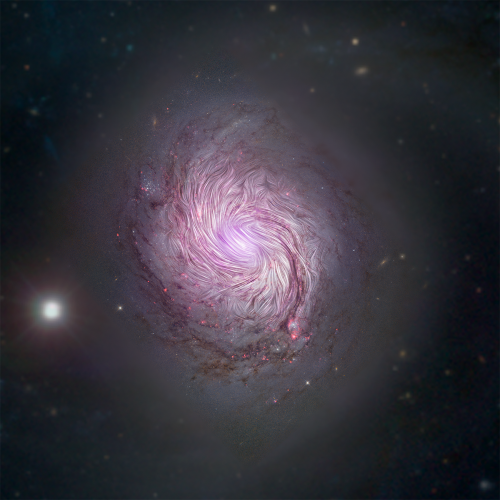
Completely invisible, yet unbelievably influential. 💫
According to new research from our Stratospheric Observatory for Infrared Astronomy (SOFIA), spiral galaxies like the Milky Way are shaped by magnetic fields. These magnetic fields are invisible to the human eye.
However, by combining imagery from our Hubble Space Telescope, the Nuclear Spectroscopic Array and the Sloan Digital Sky Survey, the magnetic fields become apparent. In this image, scientists measured the magnetic fields along the spiral arms of the galaxy called NGC 1068. The fields are shown as streamlines that closely follow the circling arms.
Image Credit: NASA/SOFIA; NASA/JPL-Caltech/Roma Tre Univ.
Make sure to follow us on Tumblr for your regular dose of space: http://nasa.tumblr.com.
From Discovering the Secrets of the Universe to In-Space Servicing, We’ve Got The Tools for the Job
If you need to fix something on Earth, you could go to a store, buy the tools you need, and get started. In space, it’s not that easy.

Aside from the obvious challenges associated with space (like it being cold and there being no gravity), developing the right tools requires a great deal of creativity because every task is different, especially when the tools need to be designed from scratch. From the time an engineer dreams up the right tools to the time they are used in space, it can be quite a process.
On Nov. 15, astronauts Luca Parmitano and Drew Morgan began a series of spacewalks to repair an instrument called the Alpha Magnetic Spectrometer (AMS-2) on the exterior of the International Space Station. The first of four spacewalk focused on using specialized tools to remove shields and covers, to gain access to the heart of AMS to perform the repairs, and install a new cooling system.

The debris shield that covered Alpha Magnetic Spectrometer floats away toward Earth as astronaut Drew Morgan successfully releases it.
Once repaired, AMS will continue to help us understand more about the formation of the universe and search for evidence of dark matter and antimatter.
These spacewalks, or extravehicular activities (EVAs), are the most complex of their kind since the servicing of the Hubble Space Telescope. AMS is particularly challenging to repair not only because of the instrument’s complexity and sensitivity, but also because it was never designed to be fixed. Because of this design, it does not have the kinds of interfaces that make spacewalks easier, or the ability to be operated on with traditional multi-purpose tools. These operations are so complex, their design and planning has taken four years. Let’s take a look at how we got ready to repair AMS.

Thinking Outside of the (Tool) Box
When designing the tools, our engineers need to keep in mind various complications that would not come into play when fixing something on Earth. For example, if you put a screw down while you’re on Earth, gravity will keep it there — in space, you have to consistently make sure each part is secure or it will float away. You also have to add a pressurized space suit with limited dexterity to the equation, which further complicates the tool design.

In addition to regular space complications, the AMS instrument itself presents many challenges — with over 300,000 data channels, it was considered too complex to service and therefore was not designed to one day be repaired or updated if needed. Additionally, astronauts have never before cut and reconnected micro-fluid lines (4 millimeters wide, less than the width of the average pencil) during a spacewalk, which is necessary to repair AMS, so our engineers had to develop the tools for this big first.

With all of this necessary out-of-the-box thinking, who better to go to for help than the teams that worked on the most well-known repair missions — the Hubble servicing missions and the space station tool teams? Building on the legacy of these missions, some of our same engineers that developed tools for the Hubble servicing missions and space station maintenance got to work designing the necessary tools for the AMS repair, some reworked from Hubble, and some from scratch. In total, the teams from Goddard Space Flight Center’s Satellite Servicing Projects Division, Johnson Space Center, and AMS Project Office developed 21 tools for the mission.
Designing and Building
Like many great inventions, it all starts with a sketch. Engineers figure out what steps need to be taken to accomplish the task, and imagine the necessary tools to get the job done.
From there, engineers develop a computer-aided design (CAD) model, and get to building a prototype. Tools will then undergo multiple iterations and testing with the AMS repair team and astronauts to get the design just right, until eventually, they are finalized, ready to undergo vibration and thermal vacuum testing to make sure they can withstand the harsh conditions of launch and use in the space environment.
Hex Head Capture Tool Progression:

Hex Head Capture Tool Used in Space:

Practice Makes Perfect
One of the reasons the AMS spacewalks have been four years in the making is because the complexity of the repairs required the astronauts to take extra time to practice. Over many months, astronauts tasked with performing the spacewalks practiced the AMS repair procedures in numerous ways to make sure they were ready for action. They practiced in:
Virtual reality simulations:

The Neutral Buoyancy Laboratory:

The Active Response Gravity Offload System (ARGOS):

Astronauts use this testing to develop and practice procedures in space-like conditions, but also to figure out what works and doesn’t work, and what changes need to be made. A great example is a part of the repair that involves cutting and reconnecting fluid lines. When astronauts practiced cutting the fluid lines during testing here on Earth, they found it was difficult to identify which was the right one to cut based on sight alone.
The tubes on the AMS essentially look the same.

After discussing the concern with the team monitoring the EVAs, the engineers once again got to work to fix the problem.

And thus, the Tube Cutting Guide tool was born! Necessity is the mother of invention and the team could not have anticipated the astronauts would need such a tool until they actually began practicing. The Tube Cutting Guide provides alignment guides, fiducials and visual access to enable astronauts to differentiate between the tubes. After each of eight tubes is cut, a newly designed protective numbered cap is installed to cover the sharp tubing.

Off to Space

With the tools and repair procedures tested and ready to go, they launched to the International Space Station earlier this year. Now they’re in the middle of the main event -- Luca and Drew completed the first spacewalk last Friday, taking things apart to access the interior of the AMS instrument. Currently, there are three other spacewalks scheduled over the course of a month. The next spacewalk will happen on Nov. 22 and will put the Tube Cutting Guide to use when astronauts reconnect the tubes to a new cooling system.
With the ingenuity of our tool designers and engineers, and our astronauts' vigorous practice, AMS will be in good hands.

Check out the full video for the first spacewalk. Below you can check out each of the tools above in action in space!
Debris Shield Worksite: 2:29:16 – Debris Shield Handling Aid 2:35:25 – Hex Head Capture Tool (first) 2:53:31 – #10 Allen Bit 2:54:59 – Capture Cages 3:16:35 – #10 Allen Bit (diagonal side) 3:20:58 – Socket Head Capture Tool 3:33:35 – Hex Head Capture Tool (last) 3:39:35 – Fastener Capture Block 3:40:55 – Debris Shield removal 3:46:46 – Debris Shield jettison
Handrail Installations: 4:00:53 – Diagonal Beam Handrail Install 4:26:09 – Nadir Vacuum Case Handrail Install 4:33:50 – Zenith Vacuum Case Handrail InstallVertical Support Beam (VSB)
Vertical Support Beam (VSB) Worksite: 5:04:21 – Zip Tie Cutter 5:15:27 – VSB Cover Handling Aid 5:18:05 – #10 Allen Bit 5:24:34 – Socket Head Capture Tool 5:41:54 – VSB Cover breaking 5:45:22 – VSB Cover jettison 5:58:20 – Top Spacer Tool & M4 Allen Bit 6:08:25 – Top Spacer removal 7:42:05 - Astronaut shoutout to the tools team
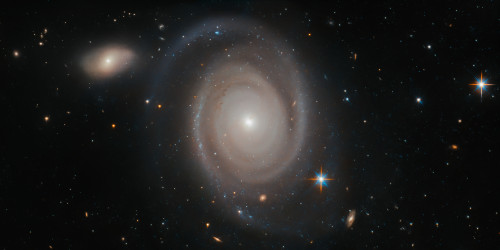
Not all galaxies are lonely. Some have galaxy squads.
NGC 1706, captured in this image by our Hubble Space Telescope, belongs to something known as a galaxy group, which is just as the name suggests — a group of up to 50 galaxies which are gravitationally bound and relatively close to each other.
Our home galaxy, the Milky Way, has its own squad — known as the Local Group, which also contains the Andromeda galaxy, the Large and Small Magellanic clouds and the Triangulum galaxy.
Make sure to follow us on Tumblr for your regular dose of space: http://nasa.tumblr.com.

O_o When we peer deep into space, we don't expect to find something staring back at us...
This galactic ghoul, captured by our Hubble Space Telescope, is actually a titanic head-on collision between two galaxies. Each "eye" is the bright core of a galaxy, one of which slammed into another. The outline of the face is a ring of young blue stars. Other clumps of new stars form a nose and mouth.
Although galaxy collisions are common most of them are not head-on smashups like this Arp-Madore system. Get spooked & find out what lies inside this ghostly apparition, here.
Make sure to follow us on Tumblr for your regular dose of space: http://nasa.tumblr.com
The Overview Effect
Observing Earth from space can alter an astronauts’ cosmic perspective, a mental shift known as the “Overview Effect.” First coined by space writer Frank White in 1987, the Overview Effect is described as a feeling of awe for our home planet and a sense of responsibility for taking care of it.
See Earth from the vantage point of our astronauts in these perspective-changing views:
Floating Free in Space

Astronaut Bruce McCandless II used his hands to control his movement above the Earth during the first-ever spacewalk that didn't use restrictive tethers and umbilicals. Fellow crew members aboard the space shuttle Challenger captured this image on Feb. 7, 1984, through windows on the flight deck.
Of his famous spacewalk, McCandless wrote in 2015: "My wife [Bernice] was at mission control, and there was quite a bit of apprehension. I wanted to say something similar to Neil [Armstrong] when he landed on the moon, so I said, 'It may have been a small step for Neil, but it’s a heck of a big leap for me.' That loosened the tension a bit."
Earth Reflections

Astronaut Tracy Caldwell Dyson looks through a window in the Cupola of the International Space Station (ISS). A blue and white part of Earth and the blackness of space are visible through the windows. The image was a self-portrait using natural light.
In a preflight interview for Expedition 23/24, Dyson said: “hands down, the best part about it is being able to look at that view every day and during the time frame we’ll be up there, hopefully, we’ll have a big bay window and much more opportunity to observe this beautiful planet.”
Taking in the View

As astronaut Nick Hague prepared to conclude his six-month stay aboard the ISS, he shared this photo saying: "Today is my last Monday living on this orbiting laboratory and I’m soaking up my final views. The @Space_Station is truly an engineering marvel. #MondayMotivation."
He and Expedition 60 and Soyuz commander Alexey Ovchinin of the Russian space agency Roscosmos completed a 203-day mission, spanning 3,248 orbits of Earth, and a journey of 80.8 million miles.
Earthrise

On Dec. 24, 1968, Apollo 8 astronauts Frank Borman, Jim Lovell and Bill Anders became the first humans to witness the Earth rising above the Moon's surface.
Anders, photographing the Moon from the right-side window, caught sight of the view, and exclaimed: “Oh my God, look at that picture over there! There’s the Earth comin’ up. Wow, is that pretty!”
The Blue Marble

Besides Earthrise, the Blue Marble is probably the most famous image of Earth that NASA has produced. Taken by the Apollo 17 crew on their way to the Moon in 1972, the Blue Marble and other NASA imagery of Earth has been credited by some with helping to fuel the environmental movement.
For more information on the Overview Effect, check out this episode of Houston We Have a Podcast.
Make sure to follow us on Tumblr for your regular dose of space: http://nasa.tumblr.com

Say hello to the Saturn Nebula 👋
Garden-variety stars like the Sun live fairly placid lives in their galactic neighborhoods, casually churning out heat and light for billions of years. When these stars reach retirement age, however, they transform into unique and often psychedelic works of art. This Hubble Space Telescope image of the Saturn Nebula shows the result, called a planetary nebula. While it looks like a piece of wrapped cosmic candy, what we see is actually the outer layers of a dying star.
Stars are powered by nuclear fusion, but each one comes with a limited supply of fuel. When a medium-mass star exhausts its nuclear fuel, it will swell up and shrug off its outer layers until only a small, hot core remains. The leftover core, called a white dwarf, is a lot like a hot coal that glows after a barbecue — eventually it will fade out. Until then, the gaseous debris fluoresces as it expands out into the cosmos, possibly destined to be recycled into later generations of stars and planets.
Using Hubble’s observations, scientists have characterized the nebula’s composition, structure, temperature and the way it interacts with surrounding material. Studying planetary nebulas is particularly interesting since our Sun will experience a similar fate around five billion years down the road.
Make sure to follow us on Tumblr for your regular dose of space: http://nasa.tumblr.com.

We are swooningggg over this NEW Saturn image.
Saturn is so beautiful that astronomers cannot resist using the Hubble Space Telescope to take yearly snapshots of the ringed world when it is at its closest distance to Earth. 😍
These images, however, are more than just beauty shots. They reveal exquisite details of the planet as a part of the Outer Planets Atmospheres Legacy project to help scientists understand the atmospheric dynamics of our solar system's gas giants.
This year's Hubble offering, for example, shows that a large storm visible in the 2018 Hubble image in the north polar region has vanished. Also, the mysterious six-sided pattern – called the "hexagon" – still exists on the north pole. Caused by a high-speed jet stream, the hexagon was first discovered in 1981 by our Voyager 1 spacecraft.
Saturn's signature rings are still as stunning as ever. The image reveals that the ring system is tilted toward Earth, giving viewers a magnificent look at the bright, icy structure.
Image Credit: NASA, ESA, A. Simon (GSFC), M.H. Wong (University of California, Berkeley) and the OPAL Team
Make sure to follow us on Tumblr for your regular dose of space: http://nasa.tumblr.com
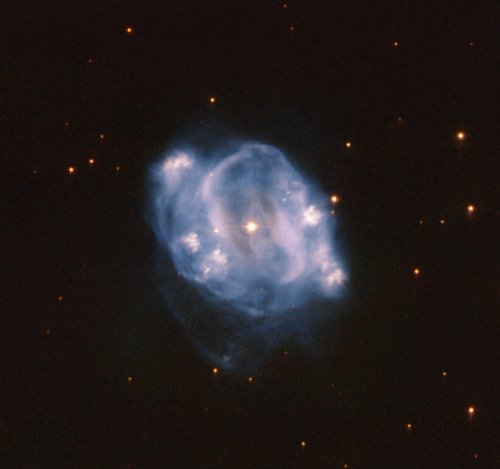
Twinkle, twinkle, little star, How I wonder what you are. Up above the world so high, Like a diamond in the sky. 🌟 The final stages of a star’s life allow us a glimpse into the future of our own solar system. This image from our Hubble Space Telescope shows what’s left of a star 10,000 light-years from Earth.
A star like our Sun will, at the end of its life, transform into a red giant. The core of the star will eventually collapse in on itself, ejecting the surface layers outward. After that, all that remains of the star is what we see here: glowing outer layers surrounding a white dwarf star. In just a few thousand years they will have dissipated, and all that will be left to see is the dimly glowing white dwarf. More on this image, here.
Make sure to follow us on Tumblr for your regular dose of space: http://nasa.tumblr.com
Sixteen Images for Spitzer's Sweet 16! 🎂
We launched our Spitzer Space Telescope into orbit around the Sunday on Aug. 25, 2003. Since then, the observatory has been lifting the veil on the wonders of the cosmos, from our own solar system to faraway galaxies, using infrared light.
Thanks to Spitzer, scientists were able to confirm the presence of seven rocky, Earth-size planets in the TRAPPIST-1 system. The telescope has also provided weather maps of hot, gaseous exoplanets and revealed a hidden ring around Saturn. It has illuminated hidden collections of dust in a wide variety of locations, including cosmic nebulas (clouds of gas and dust in space), where young stars form, and swirling galaxies. Spitzer has additionally investigated some of the universe's oldest galaxies and stared at the black hole at the center of the Milky Way.
In honor of Spitzer's Sweet 16 in space, here are 16 amazing images from the mission.
Giant Star Makes Waves

This Spitzer image shows the giant star Zeta Ophiuchi and the bow shock, or shock wave, in front of it. Visible only in infrared light, the bow shock is created by winds that flow from the star, making ripples in the surrounding dust.
The Seven Sisters Pose for Spitzer

The Pleiades star cluster, also known as the Seven Sisters, is a frequent target for night sky observers. This image from Spitzer zooms in on a few members of the sisterhood. The filaments surrounding the stars are dust, and the three colors represent different wavelengths of infrared light.
Young Stars in Their Baby Blanket of Dust

Newborn stars peek out from beneath their blanket of dust in this image of the Rho Ophiuchi nebula. Called "Rho Oph" by astronomers and located about 400 light-years from Earth, it's one of the closest star-forming regions to our own solar system.
The youngest stars in this image are surrounded by dusty disks of material from which the stars — and their potential planetary systems — are forming. More evolved stars, which have shed their natal material, are blue.
The Infrared Helix

Located about 700 light-years from Earth, the eye-like Helix nebula is a planetary nebula, or the remains of a Sun-like star. When these stars run out of their internal fuel supply, their outer layers puff up to create the nebula. Our Sun will blossom into a planetary nebula when it dies in about 5 billion years.
The Tortured Clouds of Eta Carinae

The bright star at the center of this image is Eta Carinae, one of the most massive stars in the Milky Way galaxy. With around 100 times the mass of the Sun and at least 1 million times the brightness, Eta Carinae releases a tremendous outflow of energy that has eroded the surrounding nebula.
Spitzer Spies Spectacular Sombrero

Located 28 million light-years from Earth, Messier 104 — also called the Sombrero galaxy or M104 — is notable for its nearly edge-on orientation as seen from our planet. Spitzer observations were the first to reveal the smooth, bright ring of dust (seen in red) circling the galaxy.
Spiral Galaxy Messier 81

This infrared image of the galaxy Messier 81, or M81, reveals lanes of dust illuminated by active star formation throughout the galaxy's spiral arms. Located in the northern constellation of Ursa Major (which includes the Big Dipper), M81 is also about 12 million light-years from Earth.
Spitzer Reveals Stellar Smoke

Messier 82 — also known as the Cigar galaxy or M82 — is a hotbed of young, massive stars. In visible light, it appears as a diffuse bar of blue light, but in this infrared image, scientists can see huge red clouds of dust blown out into space by winds and radiation from those stars.
A Pinwheel Galaxy Rainbow

This image of Messier 101, also known as the Pinwheel Galaxy or M101, combines data in the infrared, visible, ultraviolet and X-rays from Spitzer and three other NASA space telescopes: Hubble, the Galaxy Evolution Explorer's Far Ultraviolet detector (GALEX) and the Chandra X-Ray Observatory. The galaxy is about 70% larger than our own Milky Way, with a diameter of about 170,000 light-years, and sits at a distance of 21 million light-years from Earth. Read more about its colors here.
Cartwheel Galaxy Makes Waves

Approximately 100 million years ago, a smaller galaxy plunged through the heart of the Cartwheel galaxy, creating ripples of brief star formation. As with the Pinwheel galaxy above, this composite image includes data from NASA's Spitzer, Hubble, GALEX and Chandra observatories.
The first ripple appears as a bright blue outer ring around the larger object, radiating ultraviolet light visible to GALEX. The clumps of pink along the outer blue ring are X-ray (observed by Chandra) and ultraviolet radiation.
Spitzer and Hubble Create Colorful Masterpiece

Located 1,500 light-years from Earth, the Orion nebula is the brightest spot in the sword of the constellation Orion. Four massive stars, collectively called the Trapezium, appear as a yellow smudge near the image center. Visible and ultraviolet data from Hubble appear as swirls of green that indicate the presence of gas heated by intense ultraviolet radiation from the Trapezium's stars. Less-embedded stars appear as specks of green, and foreground stars as blue spots. Meanwhile, Spitzer's infrared view exposes carbon-rich molecules called polycyclic aromatic hydrocarbons, shown here as wisps of red and orange. Orange-yellow dots are infant stars deeply embedded in cocoons of dust and gas.
A Space Spider Watches Over Young Stars

Located about 10,000 light-years from Earth in the constellation Auriga, the Spider nebula resides in the outer part of the Milky Way. Combining data from Spitzer and the Two Micron All Sky Survey (2MASS), the image shows green clouds of dust illuminated by star formation in the region.
North America Nebula in Different Lights

This view of the North America nebula combines visible light collected by the Digitized Sky Survey with infrared light from NASA's Spitzer Space Telescope. Blue hues represent visible light, while infrared is displayed as red and green. Clusters of young stars (about 1 million years old) can be found throughout the image.
Spitzer Captures Our Galaxy's Bustling Center

This infrared mosaic offers a stunning view of the Milky Way galaxy's busy center. The pictured region, located in the Sagittarius constellation, is 900 light-years agross and shows hundreds of thousands of mostly old stars amid clouds of glowing dust lit up by younger, more massive stars. Our Sun is located 26,000 light-years away in a more peaceful, spacious neighborhood, out in the galactic suburbs.
The Eternal Life of Stardust

The Large Magellanic Cloud, a dwarf galaxy located about 160,000 light-years from Earth, looks like a choppy sea of dust in this infrared portrait. The blue color, seen most prominently in the central bar, represents starlight from older stars. The chaotic, bright regions outside this bar are filled with hot, massive stars buried in thick blankets of dust.
A Stellar Family Portrait

In this large celestial mosaic from Spitzer, there's a lot to see, including multiple clusters of stars born from the same dense clumps of gas and dust. The grand green-and-orange delta filling most of the image is a faraway nebula. The bright white region at its tip is illuminated by massive stars, and dust that has been heated by the stars' radiation creates the surrounding red glow.
Managed by our Jet Propulsion Laboratory in Pasadena, California, Spitzer's primary mission lasted five-and-a-half years and ended when it ran out of the liquid helium coolant necessary to operate two of its three instruments. But, its passive-cooling design has allowed part of its third instrument to continue operating for more than 10 additional years. The mission is scheduled to end on Jan. 30, 2020.
Make sure to follow us on Tumblr for your regular dose of space: http://nasa.tumblr.com

Say hello to the Butterfly Nebula 👋
It looks like our Hubble Space Telescope captured an image of a peaceful, cosmic butterfly unfurling its celestial wings, but the truth is vastly more violent. In the Butterfly Nebula, layers of gas are being ejected from a dying star. Medium-mass stars grow unstable as they run out of fuel, which leads them to blast tons of material out into space at speeds of over a million miles per hour!
Streams of intense ultraviolet radiation cause the cast-off material to glow, but eventually the nebula will fade and leave behind only a small stellar corpse called a white dwarf. Our middle-aged Sun can expect a similar fate once it runs out of fuel in about six billion years.
Planetary nebulas like this one aren’t actually related to planets; the term was coined by astronomer William Herschel, who actually discovered the Butterfly Nebula in 1826. Through his small telescope, planetary nebulas looked like glowing, planet-like orbs. While stars that generate planetary nebulas may have once had planets orbiting them, scientists expect that the fiery death throes these stars undergo will ultimately leave any planets in their vicinity completely uninhabitable.
Make sure to follow us on Tumblr for your regular dose of space: http://nasa.tumblr.com.
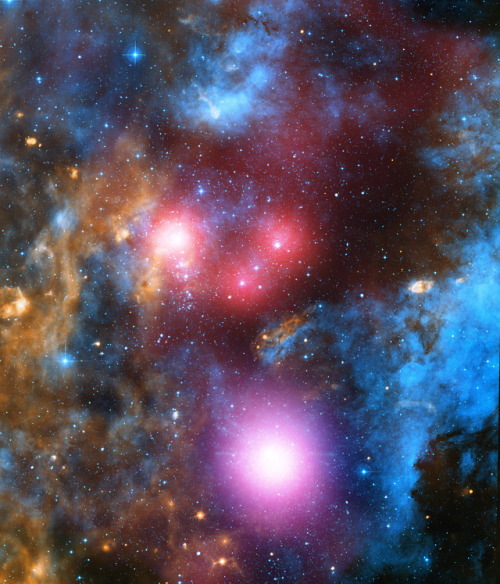
That star stuff you see here? That's what you're made of. You possess the elements ✨
This composite image from our Chandra X-ray Observatory, the Spitzer Space Telescope and the Isaac Newton Telescope shows high-energy X-rays emitted by young, massive stars in the star cluster Cygnus OB2. This year we're celebrating the 20th anniversary of Chandra's launch. Want to dive deeper? Click here
Make sure to follow us on Tumblr for your regular dose of space: http://nasa.tumblr.com.